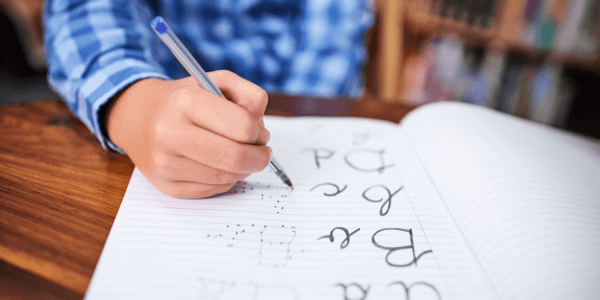ASSESSING SECOND GRADERS’ HANDWRITING USING DIGITAL TECHNOLOGY: FINDINGS FROM AN RPP IN FRANCE

OVERVIEW
The Research Artifact
The Dynamilis project (publication forthcoming)
The Dynamilis project examines and addresses elementary school students’ challenges with handwriting. Dynamilis is an evidence-based digital tool developed by School Rebound based on research done in the Human-Computer Interaction Lab of the Swiss Federal Institute of Technology. The tool uses artificial intelligence to create children’s complete handwriting profiles, including the strengths and weaknesses of their writing. Our research-practice partnership (RPP), The University House of Education (LaMue) –the first RPP initiative launched in France (Besançon)– partnered with School Rebound and the Human-Computer Interaction Lab of the Swiss Federal Institute of Technology for this project.
The RPP
The University House of Education (“Maison Universitaire de l’Education” in French and “LaMue” for short) was founded in September 2022 in Besançon, France as the first RPP in France. Partners include the University of Franche-Comté (24,000 students), the Besançon School District (200,000 students), and Besançon City Hall (120,000 stakeholders). The RPP aims to address current challenges in education through joint initiatives. The purpose of our first initiative, which we describe in this article, was to use evidence-based educational technologies to improve students’ learning. The partnership is funded by the French government under the France 2030 strategy and by the French Research Agency. LaMue is NNERPP’s first international member.
WHY THIS WORK
The Dynamilis project was initiated by Nelly Clerval, one of our practice-side RPP team members (and a co-author of this article). Nelly is a pedagogical advisor at the school district and works closely with elementary school teachers. In various district meetings and trainings, teachers shared with Nelly their observations and concerns about students not wanting to write by hand anymore and having difficulties in their handwriting. Nelly brought this issue to the RPP. Marie Mazerolle, one of our research-side team members (and also one of the authors of this article) immediately connected the observations the teachers had made to what we know about children’s handwriting from existing research: handwriting is a multifaceted, complex task that requires various skills, such as being able to pay attention, visual perception, linguistic skills, and fine motor skills (Dinehart, 2015; Feder & Majnemer, 2007). As children spend up to 30-60% of their time at school writing, handwriting difficulties can affect legibility and speed which can seriously impact both children’s behavioral and academic development (Berninger et al., 1997). Moreover, evidence supports a link between handwriting and aspects of literacy, including both reading and writing (Ray et al., 2022), and just last year, a report from France’s Department of Education found “a clear deterioration in the holding of the pencil or pen (…) and an overall lack of care in writing” (French Department of Education, 2023). Therefore, Marie took the teachers’ concerns seriously right away, affirming that early detection and remediation of handwriting difficulties is crucial (Christensen, 2009; Feder & Majnemer, 2007).
With practitioners and researchers equally interested in working to address this issue, our RPP team decided to start a new project led by Nelly and RPP Director Denis Pasco (co-author of this article). Team member Erik Gustafsson (co-author of this article) identified “Dynamilis” as a promising tool to help us examine and improve the handwriting of our local students and suggested the collaboration with “Dynamilis” developer, School Rebound, and the Computer-Human Interaction Lab of the Swiss Federal Institute of Technology.
WHAT THE WORK EXAMINES
Our project team consisted of staff and teachers from local schools, university-based researchers from the local university (University of Franche-Comté) and the Swiss Federal Institute of Technology, and engineers from School Rebound. We decided to start the project with an analysis of students’ handwriting. As practitioners noted that most of the work on handwriting is done during first and second grade, we focused on assessing second graders’ handwriting. The method consisted of collecting samples of second graders’ handwriting using Dynamilis with an iPad and a digital pen. The handwriting assessment asks students to do one basic drawing (e.g., a cat) and to copy five short sentences (e.g., “the sky is blue”). Using this input, Dynamilis is able to assess four sets of features of handwriting, including static features (i.e., purely geometric characteristics of the written text), kinematic features (i.e., dynamics of handwriting path), pressure features (i.e., characteristics of the pressure recorded between the pen tip and the tablet surface), and tilt features (i.e., characteristics of the pen tilt). Both practitioners and researchers collected the data within schools (N=134) from a sample of 1,914 second graders. We combined this data with student gender and socioeconomic status of their school, since research suggests a link between these variables and students’ handwriting.
FINDINGS
Our main findings were:
(1) Girls outperformed boys on overall handwriting scores (65 out of 100 vs. 60 out of 100) and especially on kinematic features of handwriting (i.e., dynamics of handwriting path: 64 vs. 59). The overall handwriting score is composed of the scores for the four sets of features analyzed by the Dynamilis tool as described above (static, kinematic, pressure, and tilt), each evaluated on a score between 0 and 100.
(2) More boys than girls had a high level of handwriting difficulties (i.e., <10 on 100) and more girls than boys had high handwriting scores (i.e., >90 on 100).
(3) There was a significant effect (p<.05) of school socioeconomic status on students’ overall handwriting scores. Students from high socioeconomic status schools performed 2.6% better than those attending lower socioeconomic status schools. These differences were mainly due to higher scores in the kinematics of the movement, but also due to higher scores in the pressure exerted on the digital pen.
(4) Surprisingly, we also found a significant effect of educational networks on students’ handwriting. Educational networks are networks of associated schools based on students’ path from elementary to high school, i.e., the path of elementary schools feeding into certain middle schools feeding into certain high schools. Students attending schools belonging to certain networks performed better than students attending schools belonging to other networks.
These findings were shared between our RPP team members, including researchers and practitioners, to discuss their meaning and potential next steps.
IMPACT AND USE OF THE WORK
We are currently working on next steps in this research and how these findings can make an impact in the classroom. Importantly, undertaking this project together had valuable impacts on us as a newly launched RPP and newly formed RPP team, which we share here. The Dynamilis project was one of the first to be conducted within our RPP and at the time, we didn’t have any brokers to facilitate the relationship between the members of the research and practice/policy side of our partnership. So, we learned a lot (and are still learning)!
First, we learned that researchers and practitioners definitely do not share the same language and organizational culture! We had to work out misunderstandings due to words that had different meanings in the research and practice worlds. Also, the frequent use of acronyms within the school district and the university was challenging. Each partner had to clearly explain what they wanted to say and what they meant. It took us a long time to acculturate to each other’s world and it’s still an ongoing process.
Second, our practice-side team members learned a lot about the process of doing research. When we first started this process, they were unfamiliar with the concept of a literature review. Throughout our work together, they learned about handwriting from a research literature standpoint, about the process of research design, research methodology, and data analysis. We are continuing to work on building their capacity in these areas (while always acknowledging the equally important expertise they bring!).
Lastly, our research-side team members learned a lot about the reality of teaching handwriting skills in diverse classrooms and about collecting data and engaging in joint research activities with practitioners who had no background in research. In the beginning, researchers behaved as if they were working with their doctoral students! We are continuing to work on building researchers’ capacity in these areas as well.
This first project was a big challenge for us but we learned valuable lessons that will help us going forward. Additionally, findings from this first study are having a direct impact on school district policy to support low performing students with additional resources. The district is currently working on creating these new policies based on our findings – which marks the first time the Besançon School District is taking action in response to research findings.
OPEN QUESTIONS AND NEXT STEPS
Based on this first experience of working together, practitioners and researchers from the Dynamilis project decided to push their investigation further by developing and conducting a randomized control trial study to evaluate the potential of Dynamilis handwriting games to improve first-grade students’ handwriting skills. These games include both digital and analog activities designed to help children improve their handwriting skills in playful, fun ways. They also decided to work on recommendations to the school district to support low performing students in improving handwriting skills with additional resources. The study is currently ongoing and will be followed by a research paper where we will share detailed findings from this follow-up study. We are excited to see how Besançon’s students will improve and rediscover their joy for writing.
This article was written by members of The University House of Education (Maison Universitaire de l’Éducation: La MUE) team: Nelly Clerval is Pedagogical Advisor at Besançon School District in France; Vanessa Jussy, Aurélie Vernassier, Cindy Cappelli, and Valérie Halbert-Cadet are Second Grade Teachers at Besançon School District; Denis Pasco is Professor in Educational Sciences at the University of Franche-Comté, France; Marie Mazerolle is Professor in Cognitive Sciences at the University of Franche-Comté; Erik Gustafsson is Associate Professor in Educational Technology at the University of Franche-Comté; Thibault Asselborn is Co-Founder and CEO of School Rebound in Switzerland; Lucas Burget is Doctoral Assistant in Computer-Human Interaction at the Swiss Federal Institute of Technology in Switzerland; and Pierre Dillenbourg is Professor in Computer-Human Interaction at the Swiss Federal Institute of Technology.
REFERENCES
Berninger, V. W., Vaughan, K. B., Abbott, R. D., Abbott, S. P., Rogan, L. W., Brooks, A., Reed, E., & Graham, S. (1997). Treatment of Handwriting Problems in Beginning Writers: Transfer From Handwriting to Composition. Journal of Educational Psychology, 89(4), 652–666. https://doi.org/10.1037/0022-0663.89.4.652
Christensen, C.A. (2009). The Critical Role Handwriting Plays in the Ability to Produce High-Quality Written Text. In R. Beard, D. Myhill, J. Riley, & M. Nystrand (Eds.), The SAGE Handbook of Writing Development (pp. 284-299). London, England: SAGE Publications.
Dinehart, L. H. (2015). Handwriting in Early Childhood Education : Current Research and Future Implications. Journal of Early Childhood Literacy, 15(1), 97‑118. https://doi.org/10.1177/1468798414522825
Feder, K. P., & Majnemer, A. (2007). Handwriting Development, Competency, and Intervention. Developmental Medicine and Child Neurology, 49(4), 312‑317. https://doi.org/10.1111/j.1469-8749.2007.00312.x
French Department of Education (2023). L’Enseignement de la Production d’Écrits à l’École Primaire [Teaching Writing Skills In Elementary School]. https://www.education.gouv.fr/l-enseignement-de-la-production-d-ecrits-etat-des-lieux-et-besoins-379446
Ray, K., Dally, K., Rowlandson, L., Tam, K.L, & Lane, A.E. (2022). The Relationship of Handwriting Ability and Literacy In Kindergarten: A Systematic Review. Reading and Writing, 35, 1119–1155. https://doi.org/10.1007/s11145-021-10224-8
Suggested citation: Clerval, N., Jussy, V., Vernassier, A., Cappelli, C., Halbert-Cadet, V., Pasco, D., Mazerolle, M., Gustafsson, E., Asselborn, T., Burget, L., and Dillenbourg, P. Assessing Second Graders’ Handwriting Using Digital Technology: Findings From an RPP in France. NNERPP Extra, 6(3), 2-7. https://doi.org/10.25613/Y9TS-RW29
